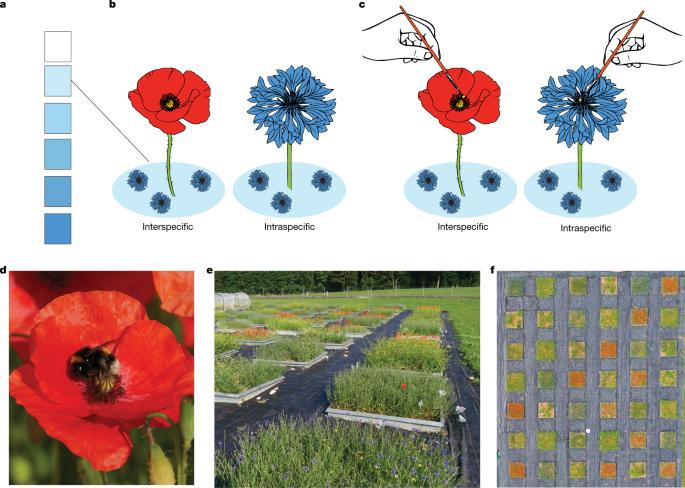Competition for pollinators destabilizes plant coexistence
IF 48.5
1区 综合性期刊
Q1 MULTIDISCIPLINARY SCIENCES
引用次数: 7
Abstract
Mounting concern over the global decline of pollinators has fuelled calls for investigating their role in maintaining plant diversity1,2. Theory predicts that competition for pollinators can stabilize interactions between plant species by providing opportunities for niche differentiation3, while at the same time can drive competitive imbalances that favour exclusion4. Here we empirically tested these contrasting effects by manipulating competition for pollinators in a way that predicts its long-term implications for plant coexistence. We subjected annual plant individuals situated across experimentally imposed gradients in neighbour density to either ambient insect pollination or a pollen supplementation treatment alleviating competition for pollinators. The vital rates of these individuals informed plant population dynamic models predicting the key theoretical metrics of species coexistence. Competition for pollinators generally destabilized the interactions between plant species, reducing the proportion of pairs expected to coexist. Interactions with pollinators also influenced the competitive imbalances between plant species, effects that are expected to strengthen with pollinator decline, potentially disrupting plant coexistence. Indeed, results from an experiment simulating pollinator decline showed that plant species experiencing greater reductions in floral visitation also suffered greater declines in population growth rate. Our results reveal that competition for pollinators may weaken plant coexistence by destabilizing interactions and contributing to competitive imbalances, information critical for interpreting the impacts of pollinator decline. Competition for pollinators weakens plant coexistence by destabilizing interactions between plant species; this is crucial for determining the effects of the decline in pollinators.

对传粉者的争夺破坏了植物共存的稳定性
传粉昆虫在全球范围内的减少引起了越来越多的关注,人们呼吁研究它们在维持植物多样性方面的作用1,2。理论预测,对传粉昆虫的竞争可以为生态位分化提供机会,从而稳定植物物种之间的相互作用3,但同时也会导致竞争失衡,有利于排斥4。在此,我们通过操纵传粉昆虫的竞争,预测其对植物共存的长期影响,从而对这些对比效应进行了实证检验。我们通过实验让位于邻近密度梯度上的一年生植物个体接受环境昆虫授粉或花粉补充处理,以缓解对传粉昆虫的竞争。这些个体的生命率为植物种群动态模型预测物种共存的关键理论指标提供了依据。对传粉昆虫的竞争通常会破坏植物物种间相互作用的稳定性,降低预期共存的配对比例。与传粉昆虫的相互作用也会影响植物物种之间的竞争失衡,这种影响预计会随着传粉昆虫的减少而加强,从而有可能破坏植物的共存。事实上,一项模拟传粉昆虫减少的实验结果表明,植物物种的花朵探访量减少得越多,其种群增长率下降得也越多。我们的研究结果表明,对传粉昆虫的竞争可能会破坏相互作用的稳定性并导致竞争失衡,从而削弱植物的共存性,这些信息对于解释传粉昆虫减少的影响至关重要。对传粉昆虫的竞争会破坏植物物种间相互作用的稳定性,从而削弱植物的共存性;这对确定传粉昆虫减少的影响至关重要。
本文章由计算机程序翻译,如有差异,请以英文原文为准。
求助全文
约1分钟内获得全文
求助全文
来源期刊

Nature
综合性期刊-综合性期刊
CiteScore
90.00
自引率
1.20%
发文量
3652
审稿时长
3 months
期刊介绍:
Nature is a prestigious international journal that publishes peer-reviewed research in various scientific and technological fields. The selection of articles is based on criteria such as originality, importance, interdisciplinary relevance, timeliness, accessibility, elegance, and surprising conclusions. In addition to showcasing significant scientific advances, Nature delivers rapid, authoritative, insightful news, and interpretation of current and upcoming trends impacting science, scientists, and the broader public. The journal serves a dual purpose: firstly, to promptly share noteworthy scientific advances and foster discussions among scientists, and secondly, to ensure the swift dissemination of scientific results globally, emphasizing their significance for knowledge, culture, and daily life.
 求助内容:
求助内容: 应助结果提醒方式:
应助结果提醒方式:


